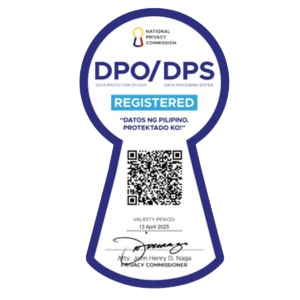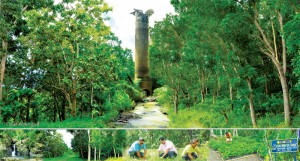 The water system of Roxas City, most commonly attributed to National Waterworks and Sewerage Authority (NAWASA) was constructed in 1929 with Sibaguan Spring (3lps) and Catao Concrete Dam (10lps) as its major sources situated at Lot 3536 CAD 338 of the cadastral survey of Capiz in Brgy Balijuagan and Sibaguan, Roxas City with an area of 458, 150 sq.meters and Lot 741 CAD 228 of the cadastral survey of Ivisan in Brgy. Cudian containing an area of 549,641 sq.meters, 4.5 km southwest of Roxas City from which a 150mmø pipeline transmits water to the service area. In 1955, the Catao Earth Dam was constructed to increase its volume capacity. The water system was later on abandoned because of its diminishing capacity.
The water system of Roxas City, most commonly attributed to National Waterworks and Sewerage Authority (NAWASA) was constructed in 1929 with Sibaguan Spring (3lps) and Catao Concrete Dam (10lps) as its major sources situated at Lot 3536 CAD 338 of the cadastral survey of Capiz in Brgy Balijuagan and Sibaguan, Roxas City with an area of 458, 150 sq.meters and Lot 741 CAD 228 of the cadastral survey of Ivisan in Brgy. Cudian containing an area of 549,641 sq.meters, 4.5 km southwest of Roxas City from which a 150mmø pipeline transmits water to the service area. In 1955, the Catao Earth Dam was constructed to increase its volume capacity. The water system was later on abandoned because of its diminishing capacity.
In October 1976, the Metro Roxas Water District (MRWD) then Roxas City Water District (RCWD) was formed by virtue of Sangguniang Panlungsod Resolution No. 45, Series of 1976, pursuant to PD 198 which has the main objective of supplying potable and affordable water to the people of Roxas City. Initially, it has 1,152 active concessionaires at the end of December 1976.
In January 20, 1977, the Local Water Utilities Administration (LWUA), the sole governing body of all local water districts issued a Certificate of Conditional Conformance Number 32 to Roxas City Water District (RCWD).
In need of a much bigger, more reliable source and much effective way of treating its supply, the Water District was compelled to a Php12.12M loan from LWUA for its Pumping Station in Arcabalo and Water Treatment Plant at Brgy. Lawa-an with a maximum initial capacity of 7,880 m³ per day and an ultimate capacity of 15,760 m³ per day as the Catao Dam cannot sustain it’s clean and enough supply of water to RCWD’s concessionaires during dry season. The loan was granted by LWUA on January 21, 1981 and the whole project was completed on December 13, 1983. Unfortunately, things did not turn out well for RCWD when the newly develop pumping station failed to live up to its expectations after its water source was gradually impregnated with salt. There is a little to be said about the newly installed facilities since the water that is being supplied to RCWD’s consumers is now potable but the problem remains the same, the supply of water was barely adequate. Thus, RCWD was forced to another loan in order to address this problem and on March 27, 1987 the Php44.0M loan, again from LWUA was granted for the construction of Paslang Pumping Station, including the 1,000 m³ Concrete Ground Reservoir in Culasi, 28 km by 400mmø SP transmission line from Panitan to Lawa-an and rehabilitation of old distribution pipelines. This made a good impression on the neighboring municipalities that on April 18, 1988 Panay and Ivisan allowed their water systems to be annexed by RCWD. This has increased the number of the Water District’s service connections at the end of December 1988 to 1,781.
In April 14, 1988/June 14, 1988, the Roxas City Water District (RCWD) was renamed to Metropolitan Roxas Water District (MRWD) by virtue of Resolution No. 13, Series of 1988, signed by the Board of Directors.
In July 8, 1989, the Paslang Pumping Station at Brgy. Salocon, Panitan was completed. Five 75hp electric motor with an average capacity of 45.5 lps were installed. This has brought significant improvement to MRWD’s services in terms of potable and ample water supply. The effect was very evident that as early as January of 1990, the number of service connections had grown to 2,303 and was almost doubled on December of 1991 when the numbers of service connections soar to 4,529.
On September 13, 1991, the Supreme Court first classified all Water Districts as Government Owned and Controlled Corporations (GOCC). All Water Districts were converted into GOCC on March 1992.
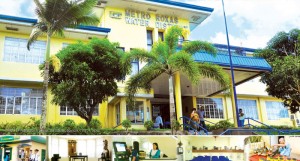 On December 1994, the number of service connections has reached to 7,194. This poses new challenge for the management as all of a sudden MRWD’s supply became critical. To augment its supply, MRWD has tried to look for new sources other than surface water and started to drill at Ivisan and Panay but with little success as there are not enough ground water sources in these areas. Finally, on the first quarter of 1995, after some series of testing, Cabugao, Quiabog and Lonoy yielded positive results, each with 7 lps, 4 lps and 3 lps discharge capacity, respectively. Cabugao, Quiabog and Lonoy Pumping Stations were constructed simultaneously but only the Cabugao Pumping Station proved sturdier as the two other pump station’s capacity have declined continuously over the years.
On December 1994, the number of service connections has reached to 7,194. This poses new challenge for the management as all of a sudden MRWD’s supply became critical. To augment its supply, MRWD has tried to look for new sources other than surface water and started to drill at Ivisan and Panay but with little success as there are not enough ground water sources in these areas. Finally, on the first quarter of 1995, after some series of testing, Cabugao, Quiabog and Lonoy yielded positive results, each with 7 lps, 4 lps and 3 lps discharge capacity, respectively. Cabugao, Quiabog and Lonoy Pumping Stations were constructed simultaneously but only the Cabugao Pumping Station proved sturdier as the two other pump station’s capacity have declined continuously over the years.
Early in September 1995, a Php10M grant expansion project of MRWD’s distribution lines to Panay started and was completed during the second quarter of 1996 raising its number of service connections at the end of the year to 8,687.
In October 1995, the feasibility study for the Metro Roxas Water Supply Systems Improvement and Expansion Project (MRWSSIEP) with an estimated cost of Php720M was completed.
MRWD tried to improve its supply by constructing a booster pump station at Arcabalo in 1997. This adds 20% to the Districts water production from 15,000 m³ to 18,000 m³.
MRWD likewise annexed Panitan Water District on January 1999.
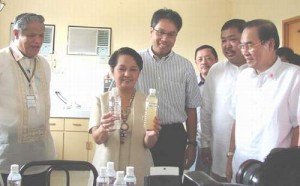 In February 22, 2000 JBIC thru LWUA granted MRWD 710.102M loan to finance MRWSSIEP. The loan was signed between LWUA and MRWD on July 5, 2000. The project was divided into three (3) phases. Phase I is the pipe laying of 600mm diameter steel pipe by 9,200 linear meter transmission lines from Paslang, Panitan to Arcabalo Relay Station. Phase II includes the pipe laying of 109 km distribution lines, constructions of 700 m³ concrete ground recervoir at Arcabalo, and 300 m³ concrete ground reservoir in Ivisan as well as the refurbishment of 1,000 m³ Culasi reservoir. Phase III is the construction of the new Water Treatment Plant with a total raw water pump discharge capacity of 30,000 m³ per day at Paslang, Panitan. The project was later on revised with the inclusion of 700 m³ concrete ground reservoir at Arcabalo to Phase I (March, 2002 – April, 2003) as well as the inclusion of WTP on Phase II (March, 2003 – September, 2006) as supplemental contracts. The new WTP has a total treated water discharge capacity of 28,000 m³ per day with 3-250hp for Roxas City and 2-50hp for Panitan.
In February 22, 2000 JBIC thru LWUA granted MRWD 710.102M loan to finance MRWSSIEP. The loan was signed between LWUA and MRWD on July 5, 2000. The project was divided into three (3) phases. Phase I is the pipe laying of 600mm diameter steel pipe by 9,200 linear meter transmission lines from Paslang, Panitan to Arcabalo Relay Station. Phase II includes the pipe laying of 109 km distribution lines, constructions of 700 m³ concrete ground recervoir at Arcabalo, and 300 m³ concrete ground reservoir in Ivisan as well as the refurbishment of 1,000 m³ Culasi reservoir. Phase III is the construction of the new Water Treatment Plant with a total raw water pump discharge capacity of 30,000 m³ per day at Paslang, Panitan. The project was later on revised with the inclusion of 700 m³ concrete ground reservoir at Arcabalo to Phase I (March, 2002 – April, 2003) as well as the inclusion of WTP on Phase II (March, 2003 – September, 2006) as supplemental contracts. The new WTP has a total treated water discharge capacity of 28,000 m³ per day with 3-250hp for Roxas City and 2-50hp for Panitan.
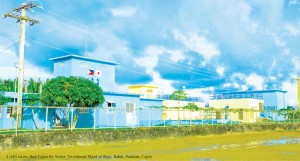 In August 03, 2007 the 30,000 m³ per day Water Treatment Plant was inaugurated by Pres. Gloria Macapagal-Arroyo. The Certificate of Final Acceptance was signed on December 14, 2007.
In August 03, 2007 the 30,000 m³ per day Water Treatment Plant was inaugurated by Pres. Gloria Macapagal-Arroyo. The Certificate of Final Acceptance was signed on December 14, 2007.
Other facilities/projects for MRWD were the Php82M loan Water Treatment Plant at Bahit, Panitan having a discharge capacity of 1,292 m³ per day and the 5 concrete ground reservoirs (one at Culasi and four at Olotayan with volume capacities of 30 m³, 20 m³, 2-15 m³ and 10 m³, respectively) including a water barge grant, all from Japan International Cooperation Agency (JICA).
Metro Roxas Water District has inevitably grown from a small water district catering only about 1,152 water connections and now categorized as Category B water district with a total number of 35,499 active service connections as of August 31, 2018.
MRWD’s main water source is the Panay River, where raw water is treated in the Water Treatment Plant with a water production capacity of 30,000 cubic meters per day. MRWD water services cover the areas of Roxas City, Municipalities of Panay, Panitan and Ivisan. It also supplies the Municipality of Sigma thru the bulk sales services.
As network expansion spur customers growth, expansion of MRWD distribution system in Roxas City and its neighboring municipalities were implemented. As some of the planned expansion were already operational, this increases MRWD expected/targeted customer by 2,286 in 2017. With the recovery of a significant volume of losses, MRWD tallied an all-time low NRW of 17%, this enables MRWD to provide its service areas with sustainable water supply with a minimal increase in its production output. In addition, MRWD endeavor to provide continuous availability of potable water to its service areas. MRWD has recommissioned Bahit Water Treatment Plant to augment the needed water supply brought about by the increase of water demand.



